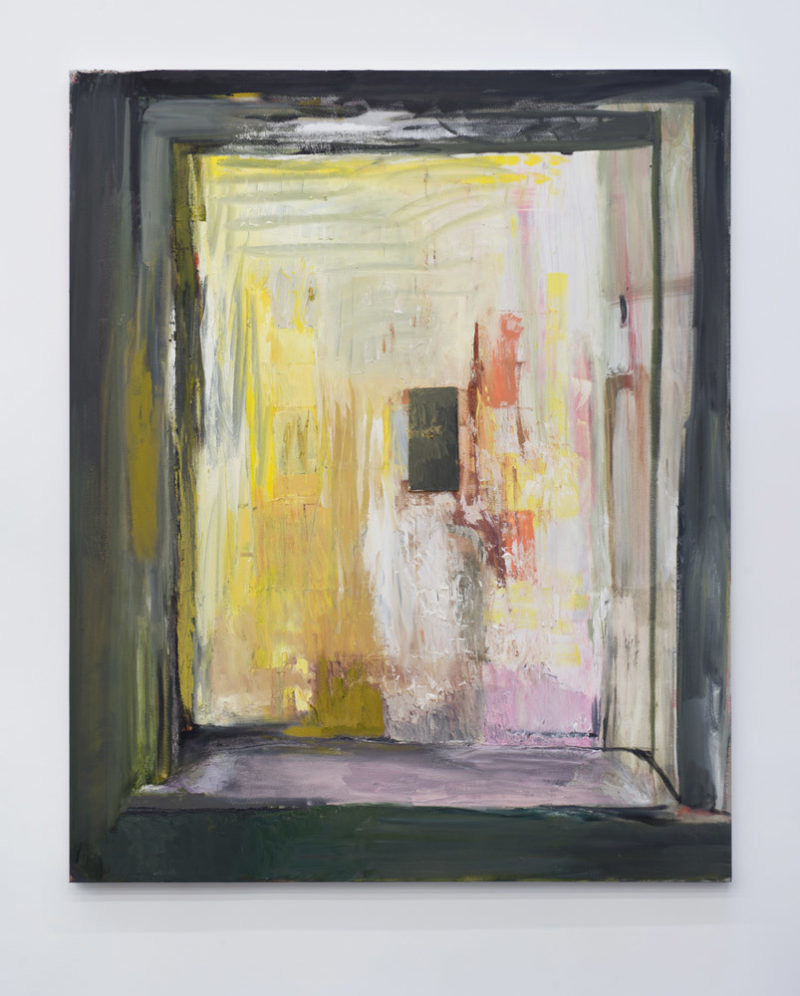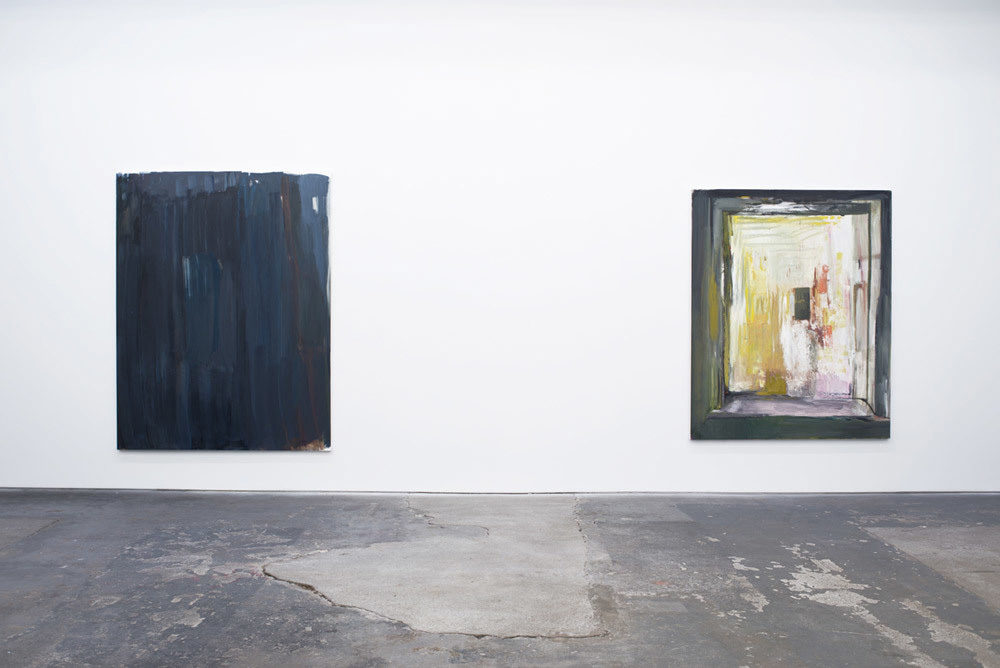
- Source: Bomb Magazine
- Author: Tom Burr
- Date: March 30, 2018
- Format: DIGITAL
Second Surfaces: RJ Messineo Interviewed by Tom Burr
Painting and architectural space
When I first met RJ Messineo at her temporary New York studio a few years back, she was wrestling with whether to make the full-time move to New York. I remember encouraging her to do so, and then wondering afterward if that advice had been sound or not. I had met RJ through her sister Christine, and then rapidly our points of connection seemed to multiply: friends in common and mutual concerns in our work. Catching up with RJ again recently, it seemed the shift to New York has been a fruitful one, with a new body of work in process for her solo exhibition Fellow Feeling at CANADA gallery. I can’t help but feel that her use of architectural interiority in these new works, her drawing on a suite of very personal rooms from her own recent life, then opening them up to an audience, also signals a moving out from the isolated space of the studio and into one of exhibition. A vulnerable but significant place to be.
—Tom Burr

RJ Messineo, Untitled, 2018. 96 x 69 x 1 7/8 inches. Courtesy of the artist and CANADA. Photo: Joe DeNardo.
Tom Burr: After looking at your recent paintings, I was compelled to think about architecture. In your older work there seemed to be more of a physical construction occurring—objects attached to objects, creating physical spaces, holes, openings within the surface. In fact the other night I was talking to Andrea Fraser, whom I know you studied with at UCLA, and she mentioned Gordon Matta-Clark in relationship to you, which I had thought about as well. In the new work it’s more about paint and the physicality of the paint, but still very much about architectural space, even interiority. I’m curious if the relationship I see to architecture and architectural space is a primary concern of yours, then and now?
RJ Messineo: Definitely. Considering the architectural spaces that we traverse and inhabit daily is a thread that, I think, runs through most of my work. Architecture positions us as bodies and as viewers. It shapes how we encounter each other and impacts what’s possible in terms of our relationships with our neighbors, with strangers, and with lovers. These are different degrees of intimacy, access, and fantasy, which are historical and structural as much as interpersonal.
In school, I was working with found and discarded materials, and allowing the physical qualities of these materials to determine the moves I was making, the formal language, etc. But despite having some sculptural methodologies at play, the work stayed oriented in relationship to the wall and tethered to two-dimensional space. Andrea was someone whose influence unexpectedly really encouraged the painter in me. And by the painter I mean the part of me that finds joy and play and possibility in the ways a painting can be its own reality set apart, not entirely contingent upon the conditions of the world as they are. I made a work in my last year of grad school at UCLA that I have since come to call “the painting for Andrea.” It started with a platform or panel someone had built that I pulled out of the dumpster. I cut the four corners out of it, which was quoting Matta-Clark, hung it on the wall, balanced on three screws, and painted a section of it this dreamy purple mauve color. It was about painting as a way to find pleasure alongside precarity.
TB: So you were thinking very directly about Matta-Clark yourself?
RJM: Yeah, he is super important, especially the way he intervened in the conventions of built spaces with these big gestural marks that pointed to, or opened up, alternate experiential possibilities. This is inspirational in terms of how I think about gesture, mark making, and creating space in painting. His documentation of the works is also important to me as images. The photographs flatten space, and the holes he made become glimpses of the exterior world framed by the interior space.

RJ Messineo, Fellow Feeling. Installation view. CANADA. Courtesy of the artist and CANADA. Photo: Joe DeNardo.
TB: So your approach might be more akin to the sort of back-and-forth fluctuation between architectural physicality and its other, the flattened plane of the document, which is referring back to that space, all the while making another sort of space within the picture plane.
RJM: Yes! The back and forth is instrumental. The CANADA show includes paintings on canvas, with moments of perspectival space; the picture plane is front and center. One painting, Fellow Feeling, is about looking out a window across the divide of the street at the window of the neighbor looking back at you. In these paintings it still feels necessary to involve physical construction, like the elements of panel as a second surface, and to deal with paint as a material. For me those second surfaces are the moments when the stuff of the world gets stuck to, and asserts itself in, all this picturing we do.
TB: Something this new body of paintings conjured for me is a sense of work that is in process, a sort of transitional space. This is something I often aspire to in my own work, an almost temporal as well as physical transition, of being in between one moment and the next. And this made me think about the moment in the mid-twentieth century when Abstract Expressionism was giving way to something else, Minimalism among other things. I thought about Eva Hesse—not so much her later work but that transitional moment, with her early student paintings that were coming out of Josef Albers, into the terrain of Abstract Expressionism, and then going someplace else, of course. Does this resonate with you at all, this notion of a sort of fluidity in the work, not exactly here, not exactly there? I see it as conscious and not at all “unresolved.” It’s more something that maybe counters the idea of resoluteness.
RJM: I love those Hesse paintings where the paint and the marks feel almost like objects, and the compositions are how those objects have been set down in relation to each other. They feel less about developing from one form to the next in a progressive sense, but embody the in-between. I relate to that. This desire to be in, as you call it, transitional space is a kind of refusal of something more fixed or known. I use Ab Ex’s gestural materiality, whose meanings have been historicized and institutionalized. For me, working between conventions or codes is a way to extend the possibilities or make more fluid what is familiar about that language. It makes me think about your works, like the mirrored, sometimes tinted, folding screens that incorporate their form and environment whether they’re placed inside or outside.
TB: Maybe this also has something to do with a fluidity of perception. I suppose the mirrored screens perform as paintings, or photographs even, as much as they perform as sculptural form.
RJM: Yes!

RJ Messineo, Fellow Feeling, 2018. Oil on wood and canvas. 80 x 65 1/8 x 1 7/8 inches. Courtesy of the artist and CANADA. Photo: Joe DeNardo.
TB: Related to that question, I’m curious if you see “qualities” in your work that you would be comfortable calling queer, or is it instead an approach to the work, and the fact that it’s you, with your body and your life, who has authored it?
RJM: Sure, this is something you and I have talked about in the past. I would say we might be similarly unresolved around this idea of queer form. I do know that my lived experience shapes the work. Sensitivity, and even vigilance, around social codes and a self-conscious navigation of the experience of looking and being looked at is like second nature to many queer or trans people for reasons of safety. Or, we’re close readers because we are looking for connection. I like your word approach because it brings to mind the image of coming toward. Like, an approach is a psychology maybe that finds expression though material qualities such as gesture, value, or surface.
TB: Going back to the architectural space of the paintings in the show, is this now a general sense of space, of light, and of rooms? Or are the spaces specific places, actual rooms, facades, walls, etc., that you’ve experienced?
RJM: They are specific. I haven’t lived in New York very long, and for the first two years here I lived in a small apartment building in Bed-Stuy. It was a brick walk-up with three apartments stacked on top of each other in a block of similar buildings. The paintings in the show are all made in relation to my experience of this building and what it was like to develop relationships with my neighbors—both as a white person living in this historically black neighborhood that is truly under siege, and as a trans person who is often read very differently by different people. During the time I lived on that block there were at least seven buildings that were sold and completely gutted and rebuilt from the inside out. I felt I needed to study the details of the buildings as they were and commit something of them to memory because in a month or a year they would be gone. My focus on architecture is not an erasure of the people, but it’s a meditation on our experience of the structures that bring us into proximity and set us apart; these structures open up our interior lives.

RJ Messineo, Fellow Feeling. Installation view. CANADA. Courtesy of the artist and CANADA. Photo: Joe DeNardo.
RJ Messineo: Fellow Feeling is on view at CANADA until April 8.
Tom Burr’s work has been associated with site-specificity, institutional and contextual critique, and explorations of queer subjectivity and space. Using architectural and spatial installation, sculpture, photography, and collage, Burr has shown his work widely since the early 1990s. Solo exhibitions have included Secession, Vienna; The Whitney Museum of American Art, New York; Museum fur Gegenwartskunst, Basel; American Fine Arts, Co, New York, among others. Tom Burr, Anthology: Writings, 1991–2015, was published by Frac Champagne-Ardenne and Sternberg Press. His exhibition Sedimental is currently on view at the Savannah College of Art and Design.

